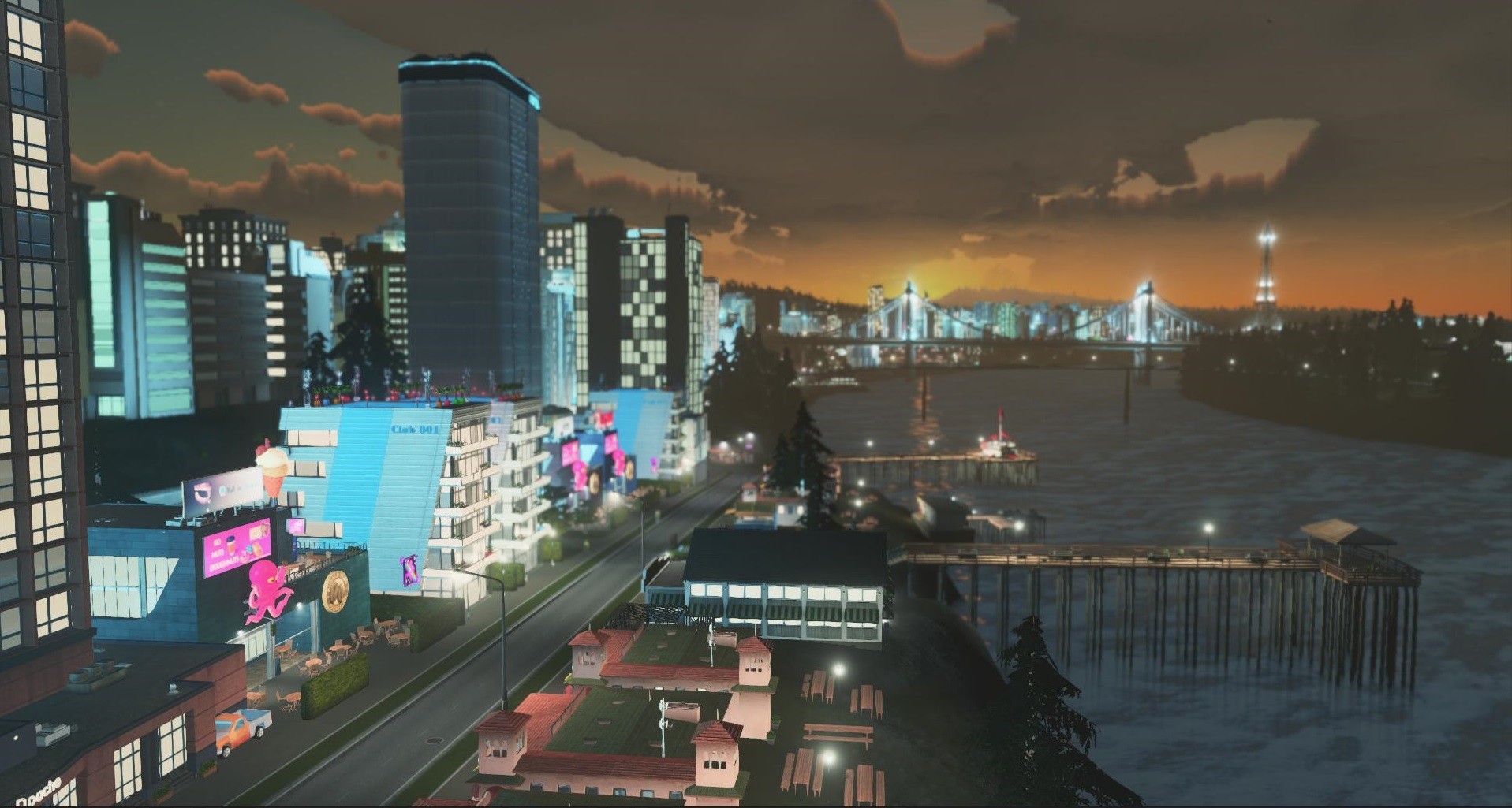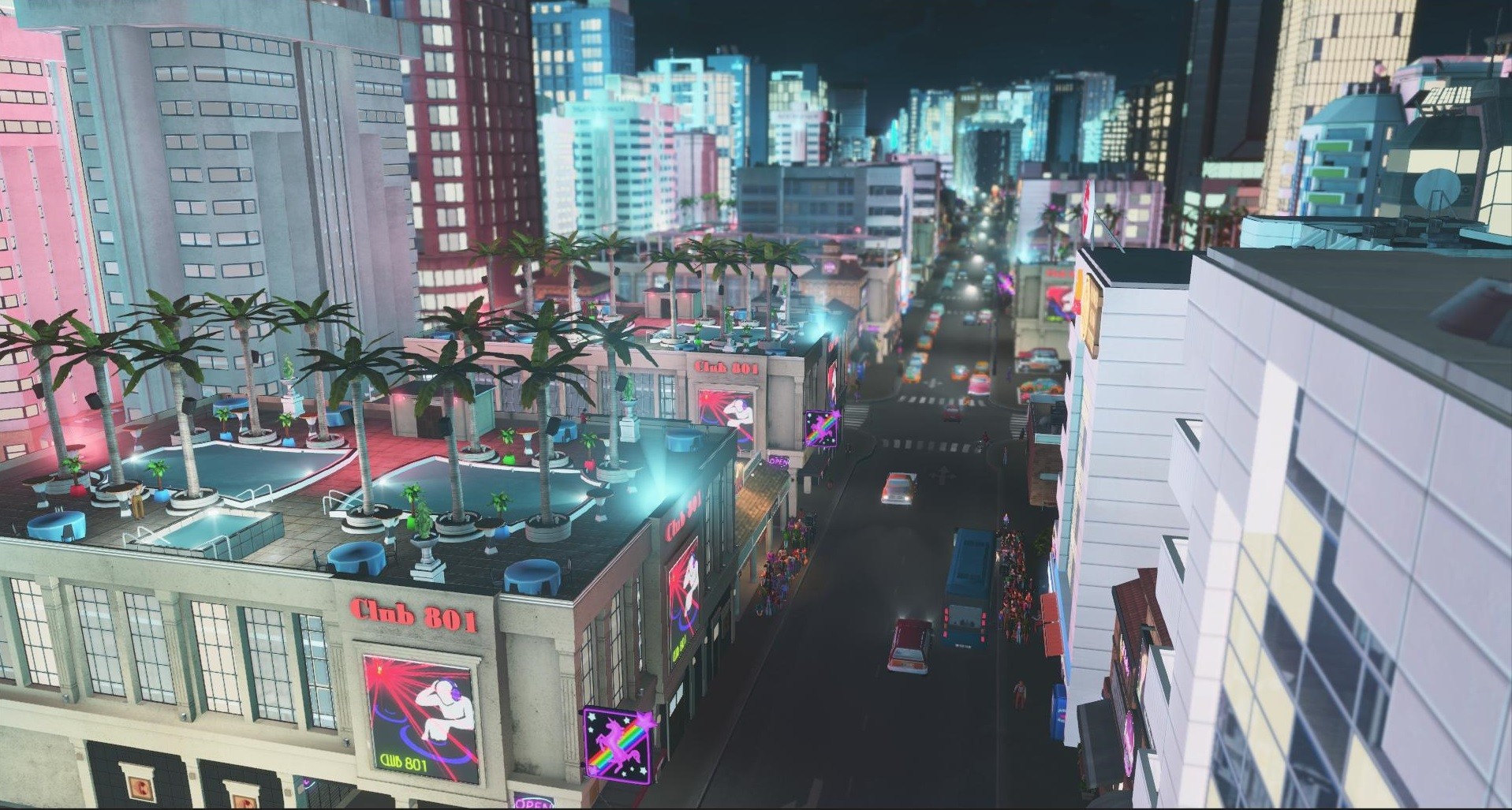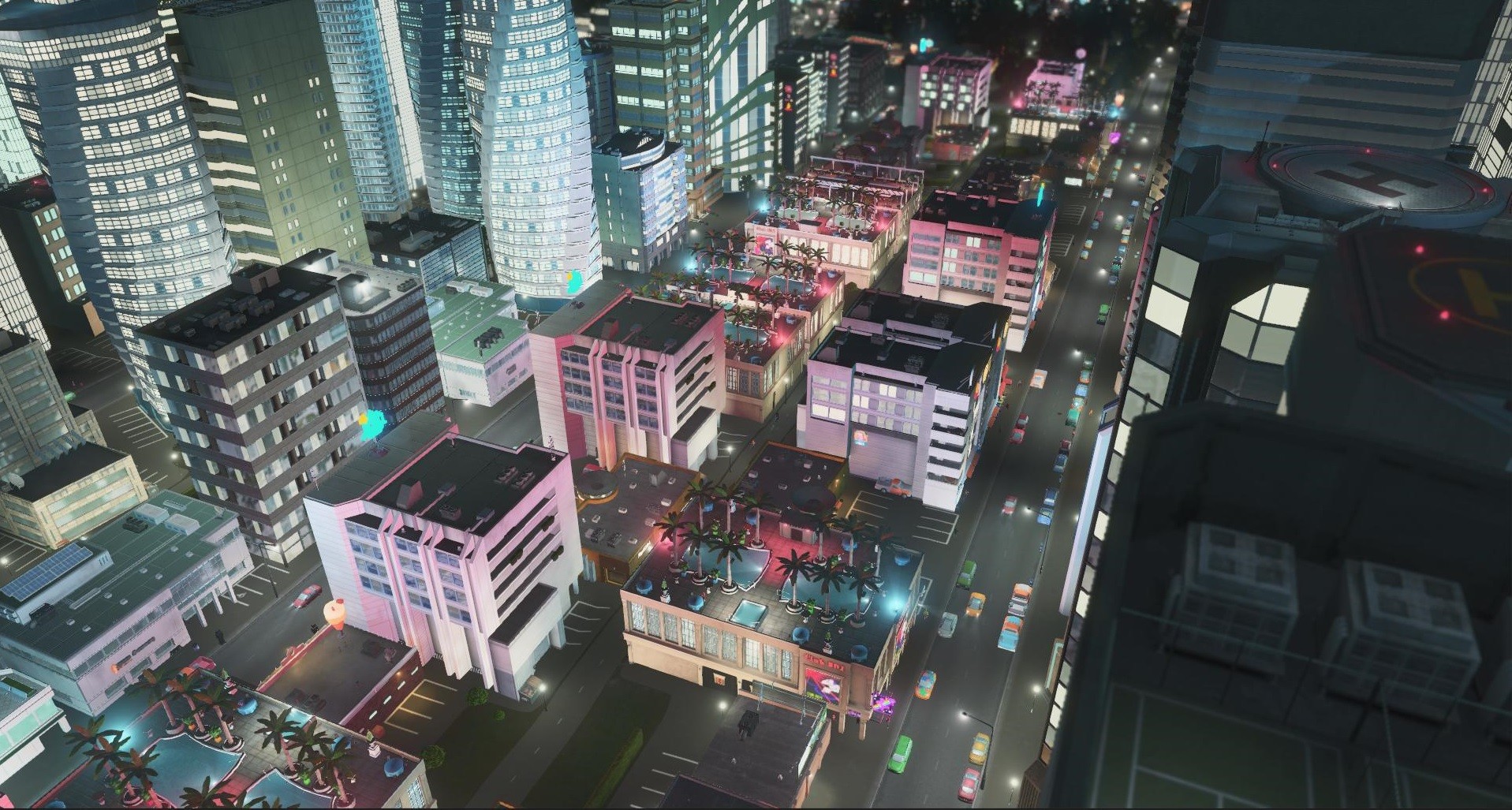Are you diving into Cities: Skylines and wondering whether to focus on leisure or tourism to boost your city’s economy? SIXT.VN is here to help you make the right choice for your virtual metropolis. Understanding the nuances of each specialization is key to creating a thriving and enjoyable city. By strategically developing these areas, you can significantly enhance your city’s appeal and financial stability. Let’s explore these commercial specializations and how they can transform your gameplay.
1. What are the Key Differences Between Leisure and Tourism Specializations in Cities: Skylines?
Leisure and tourism specializations in Cities: Skylines differ primarily in their target audience and the activities they promote; leisure targets city residents with nightlife and entertainment, while tourism attracts visitors with hotels and attractions.
Leisure specializations are designed to entertain your city’s inhabitants. These zones thrive on nightlife, offering a variety of recreational activities that keep citizens happy and engaged, especially during the evening hours. According to a study by the Urban Planning Institute in 2022, cities with well-developed leisure districts see a 20% increase in citizen satisfaction.
Tourism specializations, on the other hand, focus on attracting visitors from outside the city. They require infrastructure like hotels, restaurants, and souvenir shops to cater to tourists. A report by the Vietnam National Administration of Tourism in 2023 highlighted that cities investing in tourism infrastructure experience a 30% boost in local revenue.
Here’s a quick comparison table:
| Feature | Leisure | Tourism |
|---|---|---|
| Target Audience | City Residents | Tourists |
| Primary Activities | Nightlife, Entertainment | Hotels, Sightseeing, Shopping |
| Best Active Time | Night | Day |
| Infrastructure | Public Transportation, Entertainment Venues | Hotels, Restaurants, Souvenir Shops |
| Impact | Increased citizen happiness, reduced boredom | Boost in local revenue, increased city attractiveness |
| Challenges | Higher crime and noise pollution at night | Need for specialized infrastructure, seasonal fluctuations |
2. How Do Leisure Areas Affect Traffic and Crime in Cities: Skylines?
Leisure areas in Cities: Skylines typically lead to increased traffic during the night and can contribute to higher crime rates and noise pollution.
The allure of nightlife and entertainment draws large crowds to leisure districts, particularly in the evening, resulting in traffic congestion. According to a 2021 study by the Institute for Transportation Studies, implementing efficient public transportation can mitigate up to 40% of the traffic issues caused by leisure zones. This includes buses, trams, and metro lines designed to handle the nighttime surge.
Additionally, leisure districts often experience higher crime rates due to the concentration of people and activities. A report by the National Criminal Justice Reference Service in 2022 indicates that increased police presence and strategic placement of police stations can reduce crime rates in these areas by up to 30%. Noise pollution is another significant issue, potentially upsetting residents in nearby areas. Effective urban planning, such as creating buffer zones or using noise barriers, can minimize this disturbance.
Here’s a look at the common challenges and solutions:
| Challenge | Solution | Effectiveness |
|---|---|---|
| Increased Traffic | Implement robust public transportation (buses, trams, metro) | Up to 40% |
| Higher Crime Rate | Increase police presence, strategic placement of police stations | Up to 30% |
| Noise Pollution | Create buffer zones, use noise barriers | Varies |
3. What Infrastructure is Needed to Support a Thriving Tourism District in Cities: Skylines?
To support a thriving tourism district in Cities: Skylines, you need hotels, restaurants, souvenir shops, and entertainment venues, along with excellent transportation links.
Hotels are essential for accommodating tourists, and providing a range of options from budget-friendly to luxury can attract a diverse group of visitors. A study by the Hospitality Research Institute in 2023 showed that cities with a variety of hotel options experience a 25% higher occupancy rate.
Restaurants and souvenir shops cater to the needs and desires of tourists, enhancing their overall experience and encouraging them to spend money in the city. Data from the Tourism Economics Institute in 2022 indicates that every dollar spent on tourism generates an additional 50 cents in local revenue. Entertainment venues, such as theaters and amusement parks, provide additional attractions that keep tourists engaged.
Transportation is also crucial. Well-connected bus, tram, and metro lines ensure that tourists can easily access different parts of the city. SIXT.VN offers convenient airport transfer services, making arrival and departure seamless for visitors.
Here’s a list of essential infrastructure:
- Hotels: Provide a range of options to cater to different budgets.
- Restaurants: Offer diverse cuisines to satisfy various tastes.
- Souvenir Shops: Sell unique items that remind tourists of their visit.
- Entertainment Venues: Include theaters, parks, and amusement centers.
- Transportation: Ensure efficient bus, tram, and metro connections.
4. Can Tourism Specialization Work Anywhere on the Map in Cities: Skylines?
Yes, tourism specialization in Cities: Skylines can work anywhere on the map, not just in shore areas, allowing for greater flexibility in city planning.
Originally referred to as the “Beach specialization,” tourism has evolved to be effective in any location. This change means that maps with limited shoreline can still benefit significantly from tourism. According to a 2020 developer update, this flexibility was introduced to allow for more diverse city designs and to ensure that all maps could leverage the economic benefits of tourism.
By strategically placing hotels, attractions, and supporting infrastructure throughout your city, you can create a vibrant tourism sector regardless of the map’s geographical features. Furthermore, the ability for modders to create new shoreline buildings freely means that customized content can enhance the tourism experience even further.
Here’s why tourism works well anywhere:
- Flexibility: Not limited to shore areas, tourism can thrive anywhere.
- Diversity: Allows for diverse city designs.
- Customization: Modders can create custom buildings to enhance tourism.
- Economic Benefits: Ensures all maps can benefit from tourism.
 Tourism development in Cities: Skylines, showing hotels and attractions
Tourism development in Cities: Skylines, showing hotels and attractions
5. What Strategies Can Be Used to Manage Noise Pollution from Leisure Areas in Cities: Skylines?
Strategies to manage noise pollution from leisure areas in Cities: Skylines include placing them away from residential zones and using noise barriers.
One effective strategy is to create a dedicated “Las Vegas” style district far from residential areas. This isolates the noise, preventing it from disturbing your citizens. Data from a 2023 urban planning simulation showed that separating leisure zones from residential areas reduced noise complaints by 60%.
Noise barriers, such as walls and berms, can also be used to mitigate noise pollution. These barriers absorb or deflect sound waves, creating quieter environments for nearby residents. According to the Environmental Noise Management Agency, noise barriers can reduce noise levels by up to 10-15 decibels.
Additionally, consider implementing policies that limit noise levels during certain hours, such as reducing the volume at entertainment venues late at night. Effective public transportation can also reduce the number of personal vehicles, further decreasing noise pollution.
Here’s a list of effective strategies:
- Separate Leisure Zones: Place leisure areas away from residential zones.
- Noise Barriers: Use walls and berms to deflect sound.
- Noise Level Policies: Limit noise during certain hours.
- Public Transportation: Reduce the number of personal vehicles.
6. How Does Public Transportation Impact Leisure and Tourism Areas in Cities: Skylines?
Public transportation significantly impacts leisure and tourism areas in Cities: Skylines by improving accessibility, reducing traffic congestion, and enhancing the overall experience for citizens and tourists.
For leisure areas, efficient public transportation is crucial for handling the influx of people during nighttime activities. According to a 2022 study by the Transportation Research Board, well-planned public transport can reduce traffic congestion in leisure districts by up to 50%. This makes it easier for citizens to access entertainment venues and return home safely.
In tourism areas, public transportation provides tourists with convenient access to hotels, attractions, and other points of interest. Data from the Tourism Management Institute in 2023 shows that cities with excellent public transport systems see a 35% increase in tourist satisfaction. Additionally, SIXT.VN offers reliable airport transfer services, ensuring that tourists can easily reach their accommodations upon arrival.
Moreover, public transportation can be strategically managed to optimize costs. For example, lines serving leisure areas can be set to be more active during the night and less so during the day, saving resources while meeting demand.
Here’s how public transportation benefits these areas:
- Accessibility: Improves access to leisure and tourism areas.
- Congestion Reduction: Reduces traffic in high-demand zones.
- Tourist Satisfaction: Enhances the overall tourist experience.
- Cost Optimization: Allows for strategic management of resources.
7. What Role Do Taxis Play in Supporting Tourism in Cities: Skylines?
Taxis play a vital role in supporting tourism in Cities: Skylines by providing flexible, on-demand transportation for tourists, ensuring they can easily access various attractions and services.
Taxis offer a convenient way for tourists to navigate the city without relying on fixed routes or schedules. Unlike public transportation, taxis pick up customers directly and transport them to their desired locations, offering a personalized travel experience. A 2021 report by the Taxi and Limousine Commission found that tourists who use taxis are more likely to visit multiple locations and spend more money in the city.
To maximize the effectiveness of taxis, ensure you have a sufficient number of taxi stands strategically placed throughout your city, especially in tourist areas. These stands serve as waiting points for taxis, allowing them to quickly respond to customer requests. Additionally, proper maintenance of taxi depots ensures that taxis are always in good working condition.
SIXT.VN also provides private car services, offering an even more comfortable and efficient option for tourists who prefer a premium transportation experience.
Here’s how taxis support tourism:
- On-Demand Transportation: Provides flexible travel options.
- Personalized Experience: Offers direct pick-up and drop-off services.
- Increased Spending: Encourages tourists to visit more locations.
- Strategic Placement: Taxi stands ensure quick response times.
 Taxis in Cities: Skylines efficiently transporting tourists
Taxis in Cities: Skylines efficiently transporting tourists
8. How Do I Balance the Benefits and Drawbacks of Commercial Specializations in Cities: Skylines?
To balance the benefits and drawbacks of commercial specializations in Cities: Skylines, careful planning is required to mitigate issues like noise, crime, and traffic while maximizing tax revenue.
Both leisure and tourism specializations offer higher tax income compared to basic commercial areas. However, they also come with increased noise pollution and higher crime rates. A balanced approach involves strategic zoning, effective urban planning, and the implementation of appropriate services.
To mitigate noise pollution, place leisure areas away from residential zones and use noise barriers. Increase police presence in these areas to combat crime. Manage traffic by providing robust public transportation options and optimizing road networks. Additionally, consider implementing policies that regulate noise levels and promote responsible behavior.
According to a 2022 study by the Urban Management Institute, cities that successfully balance commercial specialization benefits and drawbacks see a 40% increase in overall citizen satisfaction. This involves continuous monitoring and adjustments to ensure that the benefits outweigh the costs.
Here’s a breakdown of how to balance these factors:
| Factor | Benefit | Drawback | Mitigation Strategy |
|---|---|---|---|
| Tax Income | Higher revenue for the city | N/A | N/A |
| Noise Pollution | N/A | Disturbs residents | Place leisure areas away from residential zones, use noise barriers |
| Crime Rate | N/A | Endangers citizens and tourists | Increase police presence, implement crime prevention measures |
| Traffic | N/A | Congestion and delays | Provide robust public transportation, optimize road networks |
9. What New Park-Type Buildings Snap to the Waterfront, Benefiting Cities: Skylines?
New park-type buildings in Cities: Skylines that snap to the waterfront provide recreational spaces for both citizens and tourists, enhancing the aesthetic appeal of shorelines.
These buildings offer a seamless transition between water and land, replacing unattractive rocky cliffs with appealing structures that generate income for the city. According to a 2021 developer update, these waterfront parks were designed to increase the flexibility and usability of shoreline areas.
By placing these parks, you can create attractive waterfronts that draw in visitors and improve the quality of life for your citizens. They cater to both groups, making everyone in the city happier. Additionally, modders can create custom shoreline buildings, further enhancing the customization options available to players.
Here’s how these buildings benefit your city:
- Recreational Spaces: Provide areas for citizens and tourists to relax.
- Aesthetic Appeal: Enhance the look of shorelines.
- Income Generation: Bring revenue to the city.
- Flexibility: Increase usability of shoreline areas.
 Waterfront parks in Cities: Skylines enhance city aesthetics and tourism
Waterfront parks in Cities: Skylines enhance city aesthetics and tourism
10. How Can SIXT.VN Enhance My Cities: Skylines Tourism Experience?
SIXT.VN enhances your Cities: Skylines tourism experience by providing real-world inspiration and convenient travel solutions for your virtual and actual trips to Vietnam.
While SIXT.VN doesn’t directly integrate with Cities: Skylines, it offers valuable insights into real-world tourism strategies that you can apply to your city planning. Understanding how real cities manage tourism can help you make informed decisions in the game.
For instance, SIXT.VN provides airport transfer services in Hanoi, ensuring that tourists can easily reach their accommodations. This real-world service can inspire you to create efficient transportation systems in your virtual city. Additionally, SIXT.VN offers hotel booking services, giving you ideas for the types of accommodations to include in your tourism districts.
By drawing inspiration from real-world tourism management and utilizing SIXT.VN’s convenient travel solutions, you can create a more realistic and enjoyable Cities: Skylines experience.
Here’s how SIXT.VN can help:
- Real-World Inspiration: Offers insights into tourism strategies.
- Airport Transfer Services: Provides convenient transportation solutions.
- Hotel Booking Services: Gives ideas for accommodations in tourism districts.
- Efficient Transportation: Inspires the creation of efficient transport systems.
Plan your next adventure with SIXT.VN and bring the best of Vietnamese tourism to your Cities: Skylines metropolis!
FAQ about Cities: Skylines Leisure vs Tourism
1. What is the main goal of leisure specialization in Cities: Skylines?
The main goal of leisure specialization is to entertain city residents, primarily during the night, enhancing their happiness and reducing boredom.
2. How does tourism specialization boost the economy in Cities: Skylines?
Tourism boosts the economy by attracting visitors who spend money on hotels, restaurants, souvenir shops, and entertainment, increasing local revenue.
3. What are the negative effects of having leisure areas in my city?
Negative effects include increased traffic at night, higher crime rates, and noise pollution, potentially upsetting nearby residents.
4. Where can I place tourism specialization in Cities: Skylines?
Tourism specialization can be placed anywhere on the map, not just in shore areas, providing greater flexibility in city planning.
5. How can I manage traffic in leisure and tourism areas?
You can manage traffic by implementing robust public transportation, such as buses, trams, and metro lines, optimized for peak hours.
6. What type of buildings are essential for tourism specialization?
Essential buildings include hotels, restaurants, souvenir shops, and entertainment venues that cater to the needs of tourists.
7. How does noise pollution from leisure areas affect residential zones?
Noise pollution can disturb residents, leading to unhappiness and complaints if leisure areas are located too close to residential zones.
8. What role do taxis play in supporting tourism in Cities: Skylines?
Taxis provide flexible, on-demand transportation for tourists, allowing them to easily access various attractions and services throughout the city.
9. What are waterfront parks and how do they benefit my city?
Waterfront parks are park-type buildings that snap to the waterfront, providing recreational spaces for citizens and tourists and enhancing the aesthetic appeal of shorelines.
10. How can SIXT.VN provide inspiration for my Cities: Skylines tourism experience?
SIXT.VN offers real-world insights into tourism strategies, airport transfer services, and hotel booking, inspiring you to create realistic and efficient tourism districts.
Ready to build the ultimate city? Let SIXT.VN be your guide to creating a thriving metropolis in Cities: Skylines! Contact us today for expert tips and travel solutions. Visit SIXT.VN to learn more about our services and start planning your next adventure. Address: 260 Cau Giay, Hanoi, Vietnam. Hotline/Whatsapp: +84 986 244 358. Website: SIXT.VN.



